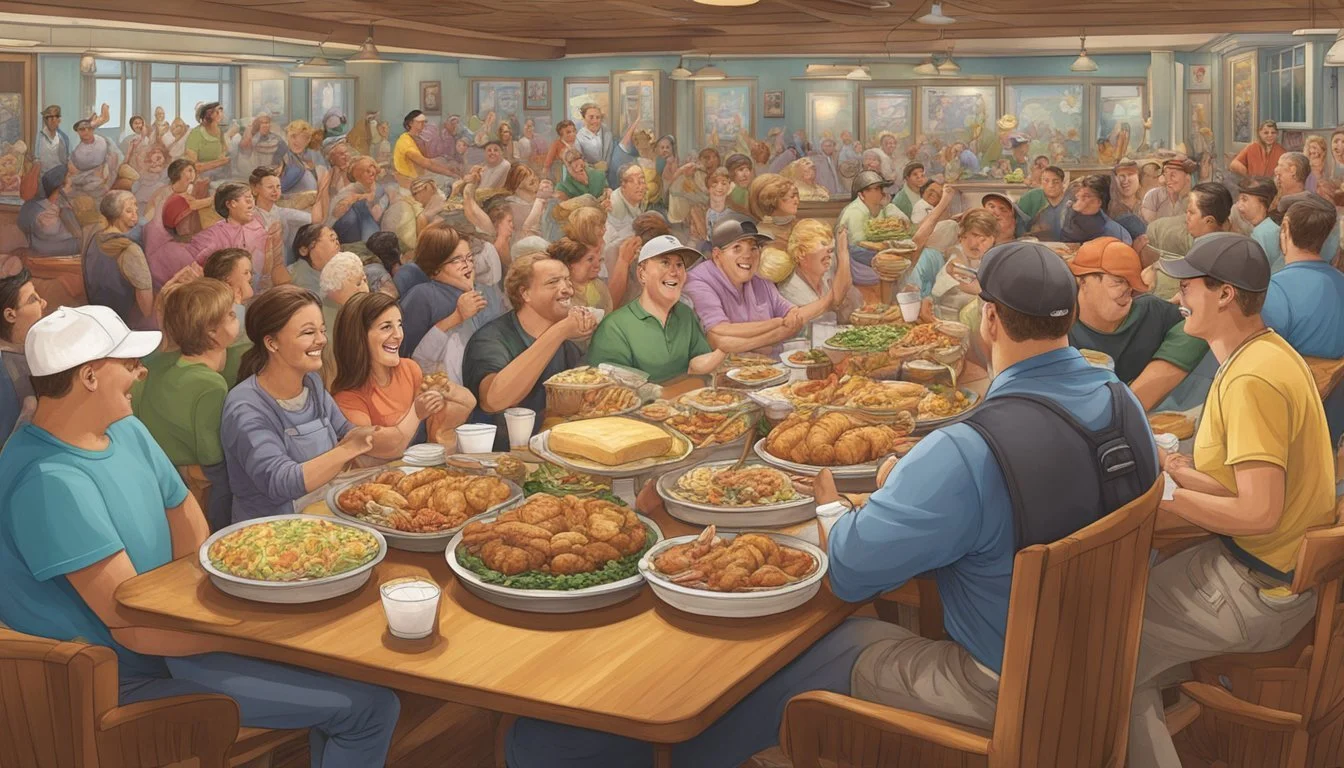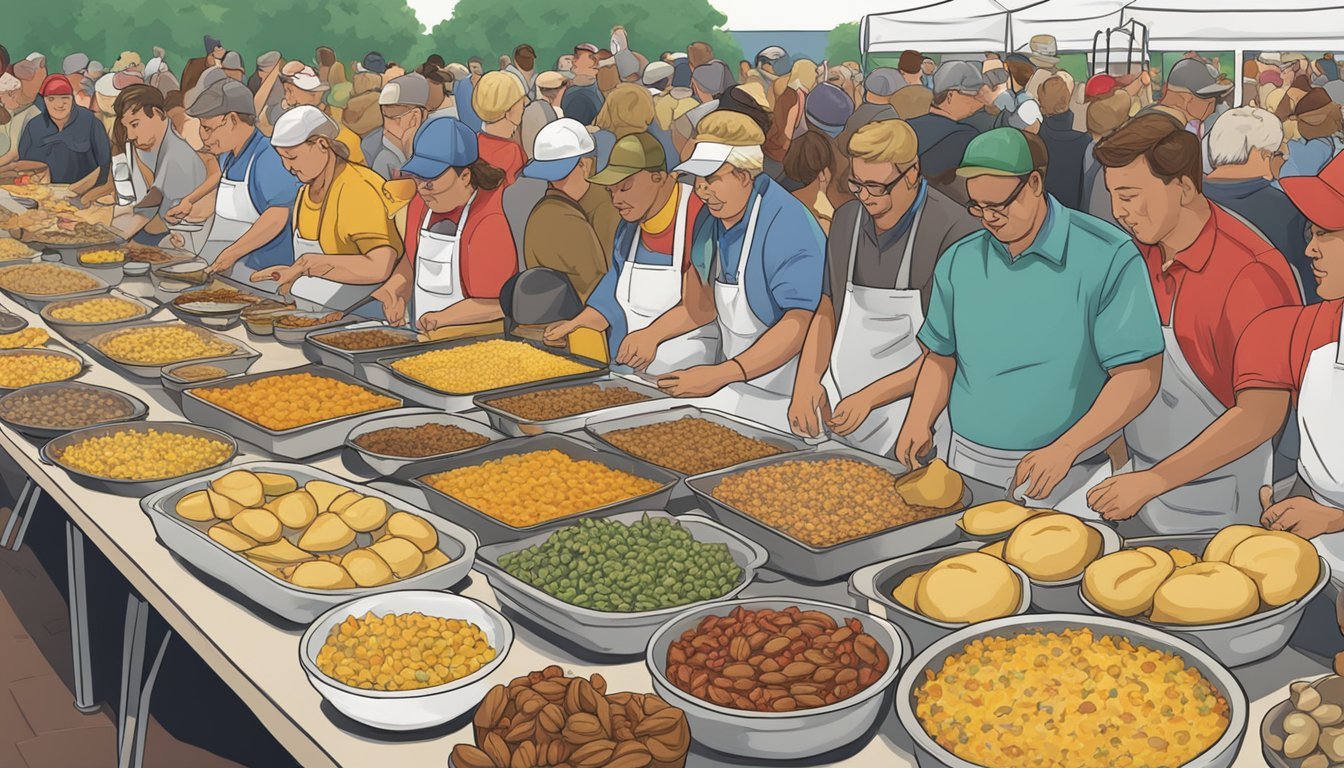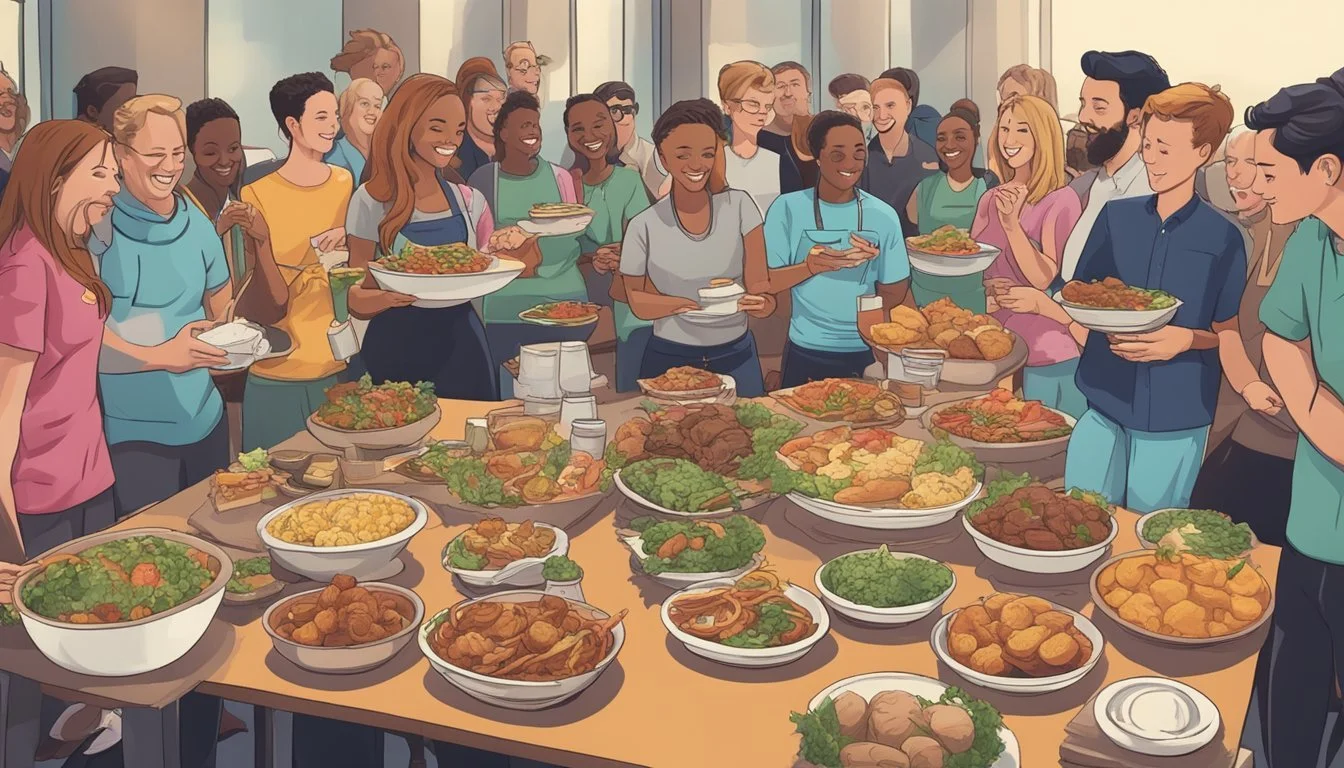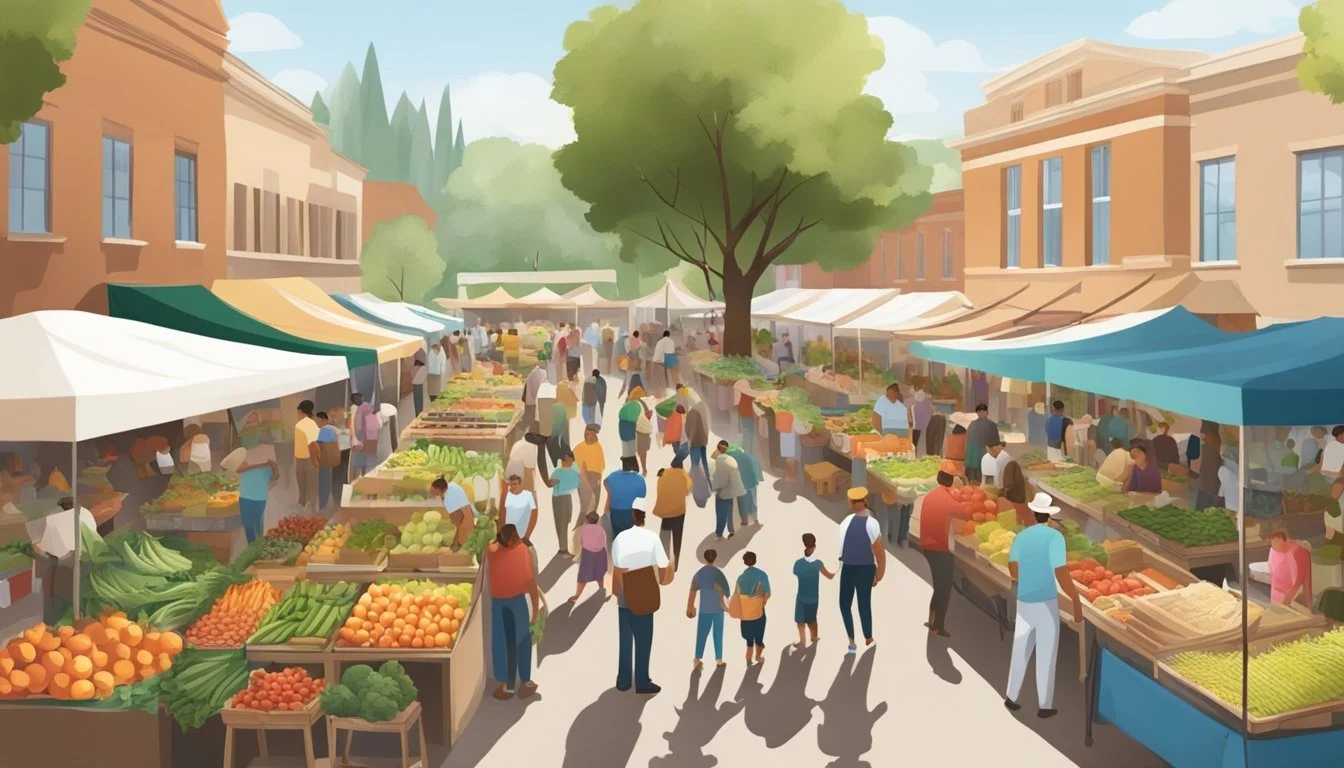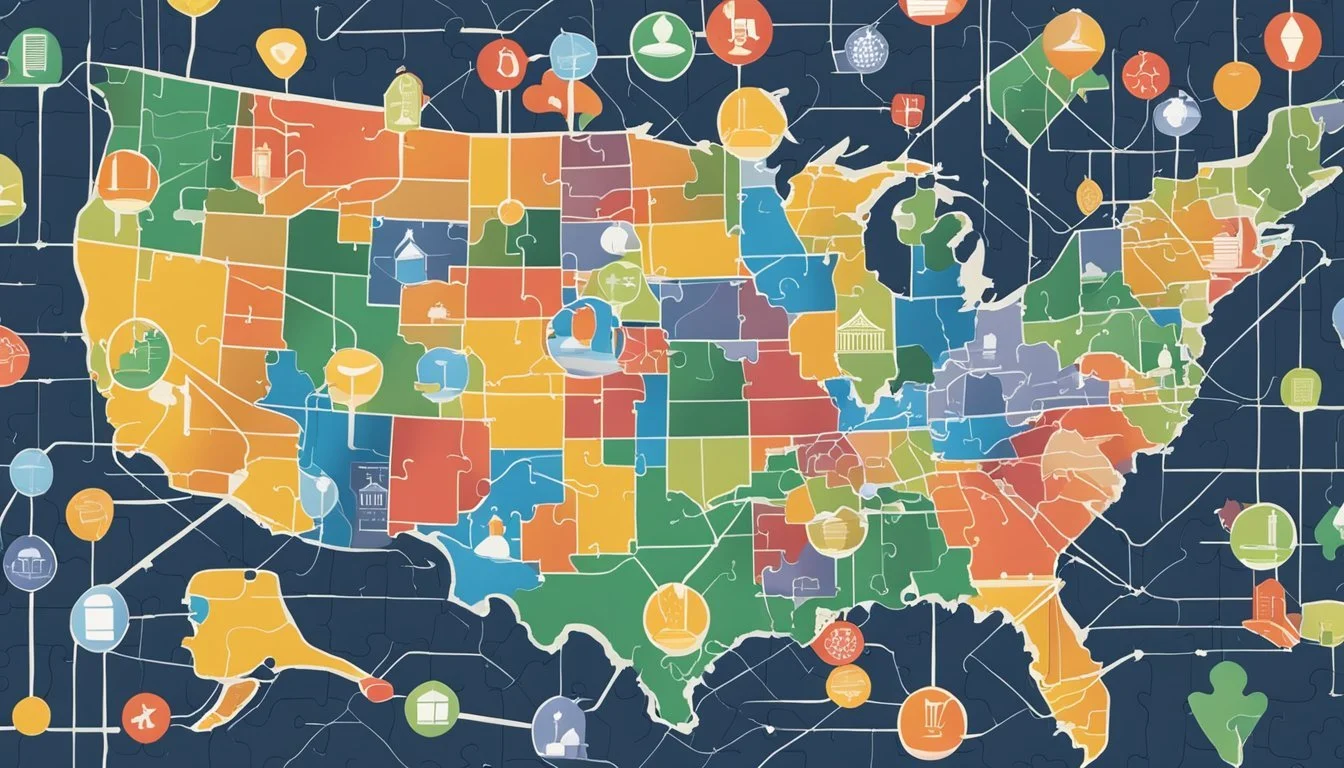Ohio Food Challenges
Your Ultimate Guide to Epic Eating Contests
Ohio stands as a vibrant collage of cultures with a rich tapestry of culinary delights, and it's no surprise that food challenges have become a prominent aspect of dining in the Buckeye State. These gastronomical feats attract both locals and visitors alike, who are eager to test their culinary limits. Occasionally characterized by oversized portions or incredibly spicy offerings, these contests are as much about community and entertainment as they are about the food itself.
Food challenges across Ohio vary widely, from tackling mountainous burgers and colossal pizzas to consuming painfully spicy wings. Participants are often driven by the lure of cash prizes, free meals, or simply the bragging rights and glory that come with conquering such an imposing edible adversary. While some are designed for solo participants, others require teamwork, making them a unique way to bond and create lasting memories.
Restaurants throughout Ohio, from the bustling streets of Columbus to the scenic corners of the state, have embraced the food challenge trend. The offerings are as diverse as the locales, with each establishment adding its unique flair to the challenge. These contests are not just tests of one's appetite but celebrations of the rich flavors and creativity found in Ohio's food scene.
Overview of Ohio Food Challenges
The food challenges of Ohio mirror the state's diverse culinary landscape, offering a range of daring experiences from towering burgers to colossal ice cream sundaes. These challenges not only test the mettle of participants but also celebrate the unique flavors of the region.
History of Food Challenges in Ohio
Ohio's history with food challenges can be traced back to local fairs and diners, where the notion of 'bigger is better' began to take root. They have since evolved from quirky local contests to well-documented affairs. The Thurmanator, a mammoth burger from the Thurman Café in Columbus, is a prime example, having gained notoriety among food challenge enthusiasts across the state.
The Role of Food Challenges in Ohio Culture
Food challenges in Ohio serve as a testament to the state’s love of community and competition. They are not just about consuming vast quantities of food, but about bringing people together. In cities like Columbus and Cincinnati, these challenges often draw crowds, becoming local spectacles that bolster camaraderie and city pride.
Popular Types of Food Challenges
Ohio presents a plethora of food challenges that cater to a variety of tastes. Here's a concise list of some popular types:
Burgers: One of the most popular types, with the legendary Thurmanator burger from Columbus being an iconic challenge.
Ice Cream: Challenges often feature mountains of ice cream, taxing the participant’s capacity to endure brain freezes as much as their appetite.
Grilled Cheese: Not for the faint-hearted, this type of challenge usually involves a stack of decadent grilled cheese sandwiches, such as those featured in the Melt Challenge from Melt Bar and Grilled.
Meal Challenges: Defined by a set meal, these challenges can vary from a full rack of ribs to a three-foot-long hotdog.
Top Food Challenges by City
Ohio's food challenges range from towering burgers to molten cheese feasts. Each city offers a distinctive eating contest that attracts both local and visiting food enthusiasts.
Columbus' Thurmanator Challenge
In Columbus, the Thurmanator Challenge takes the spotlight. Participants wrestle with a behemoth burger stacked with toppings and weighing over a pound. It's a test of endurance and appetite as contenders tackle two 12-ounce patties, lettuce, tomato, mayo, American cheese, bacon, and more, all sandwiched between a toasted bun.
Cincinnati's Blue Ash Chili Challenge
Cincinnati counters with the Blue Ash Chili Challenge. A staple of the city, Blue Ash Chili serves up a No Freakin' Way Challenge, where aspirants face off against a heaping platter of spaghetti topped with chili, cheese, fried jalapeño caps, and habanero sauce—meant for the brave of heart and hungry of stomach.
Cleveland's Melt Challenge
Cleveland's claim to culinary audacity is the Melt Challenge. The infamous Melt Bar & Grilled presents a colossal grilled cheese encompassing 13 different cheeses, a mountain of fries, and coleslaw. Weighing in at 5 pounds, the Melt Challenge has secured its place in the city's food lore, providing a gooey gauntlet for anyone daring enough to attempt it.
Understanding the Rules of Engagement
When engaging in Ohio food challenges, contenders must navigate a set of rules that ensure fair play and safety. Familiarizing oneself with these regulations is crucial to both participation and potential victory in this competitive eating arena.
Eligibility and Participation
Eligibility is defined primarily by the individual challenge requirements. Typically, these mandates state that participants must be residents of the state or at least reside within a certain proximity to the competition's location. Proof of residency may be required upon entry, and participants usually have to meet a minimum age requirement.
Pre-qualification: Some challenges, such as the Super Duper Cheesesteak Challenge, may dictate preliminary rounds or qualifying events to enter the main competition.
Judging Criteria
A clear set of judging criteria is established to ensure that the contests are assessed fairly and consistently across the board. Judges play a crucial role and are often experienced individuals within the sport of competitive eating. They monitor aspects such as:
Compliance with eating guidelines
Time limits adhered to by participants
The amount of food consumed according to the rules
Maintenance of proper conduct throughout the event
Health and Safety Regulations
Health and safety regulations are the cornerstone of competitive eating events to prevent potential risks. These may include:
Sanitation protocols to ensure food safety
Presence of medical personnel or first responders
Clear instructions for the safe consumption of large quantities of food, which may necessitate competitors to have an understanding of their own physical limits
Competitors should be aware that while competitive eating is a recognized sport, it comes with inherent risks, and they should consult with a healthcare professional before participating, especially if they have pre-existing health conditions.
Health and Economic Aspects
In Ohio, the intersection of health and economic factors significantly influences food insecurity and the operation of food-related businesses. These factors are crucial in understanding the state's approach to addressing hunger, the challenges community members face, and the strategies businesses employ to navigate the effects of inflation and supply chain disruptions.
Food Insecurity and Challenges
Food insecurity remains a pervasive issue affecting many Ohioans, with numerous communities grappling with limited access to healthy and affordable foods. The Ohio Association of Foodbanks reports that economic shocks, such as those caused by the COVID-19 pandemic, have exacerbated food insecurity, especially among marginalized populations. Factors such as poverty, unemployment, and underemployment have also contributed to increased reliance on food assistance programs. SNAP benefits, while helpful, often fall short in fully addressing the needs of those struggling with hunger. Farmers and member organizations work in partnership with food banks to supply fresh produce; however, supply chain issues have sometimes hindered these efforts.
In Delaware and other Ohio counties, food insecurity intersects with health outcomes, as limited nutritional options contribute to health disparities. The effects of inflation have not only made it harder for consumers to afford nutritious food but also strained the nonprofit sector that strives to assist them.
Food Challenges as a Business Model
From the perspective of food-related businesses in Ohio, navigating a model that accommodates food security is complex. High inflation rates have caused operational costs to soar, impacting food purchase prices and logistics like shipping and freight. Businesses have had to adjust to fluctuating market demands and supply chain inconsistencies while attempting to maintain affordable prices for consumers.
The role of food banks has been pivotal in the state's response to hunger, with many operating as crucial economic and community entities. They act as a bridge between farmers, who face their own set of challenges in the agribusiness sector, and Ohioans in need. For example, partnerships between local businesses and food banks have emerged as an innovative way to alleviate food insecurity while contributing to the economic vitality of communities.
Despite these efforts, many small businesses and nonprofit organizations continue to face financial pressures while trying to serve both their customers and the community effectively. This underscores the need for robust support mechanisms and innovative solutions to ensure the sustainability of business models that prioritize food security amidst ongoing economic challenges.
Customs and Traditions in Ohio's Food Challenges
In Ohio, food challenges are not just about the size of the meal; they're entrenched in the practice of highlighting local specialties and fostering communal competitiveness.
Typical Food and Ingredients
Ohio's food challenges often feature American comfort foods with a variety of hearty ingredients. Challenges may include:
Burgers: Multiple 10-ounce patties serve as a common base in burger challenges, often stacked high and topped with layers of American cheese and mozzarella, plus a generous addition of lettuce, tomato, pickles, and onions.
Pizza: Challenges like the 28-inch Mega Meat Pizza are loaded with pepperoni, Italian sausage, ham, bacon, ground beef, and a blend of provolone and other cheeses.
Ice Cream Desserts: A classic example is the banana split, complete with several scoops of ice cream, whipped cream, and traditional toppings.
These challenges are typically rounded out with sides such as fries or onion rings. The inclusion of salad is less common but may present in some challenges to offer a nod to balance and nutrition.
Cultural Significance of Competitive Eating
Competitive eating in Ohio does more than just test the limits of one's appetite; it's a celebration of cultural identity and local cuisine. Challenges often serve as:
Community Events: They attract spectators and represent a way for locals and visitors alike to engage in a shared experience.
Historical Significance: Many challenges are deeply rooted in tradition, with some eating competitions dating back decades.
These events offer participants both local fame and, occasionally, prizes such as cash or gift certificates, incentivizing the endeavor beyond the culinary feat itself. In many ways, competitive eating challenges are as much a part of Ohio's food culture as the ingredients themselves, reflecting both the hearty Midwest appetite and the communal value placed on food as a cornerstone for gathering and celebration.
Must-Know Tips for Participants
Entering an Ohio food challenge is not just a test of one's hunger, but a sport requiring preparation and strategy. Competitors can win significant cash and prizes, and the events often bring together the local community to witness feats of competitive eating.
How to Train for an Ohio Food Challenge
Training your stomach is essential for success. Initiators should gradually increase their food intake, focusing on high-volume, low-calorie foods like watermelon and salad to expand stomach capacity without substantial weight gain. As seen in Ohio restaurants' eating challenges, some events require preliminary rounds, so it’s important to train ahead of the competition. One must also remember to stay hydrated; water can help stretch the stomach without adding calories.
Strategies for Tackling Massive Meals
When facing a massive meal, pace and technique are key factors. For instance, tackle the larger, denser items first while your appetite is strongest. Strategies for winning food challenges often include avoiding carbonated beverages during the meal as they can produce a false sense of fullness. Avoiding condiments that can contribute to flavor fatigue ensuring that each bite is as palatable as the first is also a recommended tactic. Understanding the specific challenge, whether it's handling extreme spice as in the Atomic wings challenge or a sheer volume like the Melt Challenge, plays into the strategy; always know what you're up against.
Food Challenge Destinations and Travel Tips
Exploring Ohio through its food challenges offers a unique angle on travel and local culture. Careful planning can transform a simple trip into an unforgettable journey into the world of competitive eating.
Mapping Out Food Challenges
Ohio presents an array of food challenges across its diverse cities, from the massive Thurmanator burger in Columbus and Delaware to the oversized portions of pho in Cleveland. These destinations can serve as focal points that travelers might center their itineraries around. A strategic approach might involve:
Listing potential challenges by city.
Acknowledging physical limits and scheduling challenges accordingly.
Checking availability and any need for prior reservations or qualifications.
Planning Your Food Challenge Road Trip
Constructing a road trip tailored to food challenges requires consideration of distance, time, and local attractions. Travelers might:
Select their primary city destinations, such as Columbus, Cleveland, or Beavercreek, for their rich offering of challenges.
Allocate adequate travel time between locations to ensure participation in each scheduled challenge and recovery.
Incorporate local attractions and community events, which can be found on platforms like FoodChallenges.com, to enrich the overall trip experience.
When planning, one must account for the physical demands of competitive eating and the logistics of travel, and balance these with the pleasure of discovering Ohio's cities and attractions.
Narratives and Community Impact
In Ohio, stories of resilience in the face of food insecurity are numerous, each highlighting the critical role that community networks and local organizations play in supporting residents during difficult times.
Local Heroes and Hall of Fame
Local Heroes have been instrumental in Ohio’s response to food insecurity, particularly during the COVID-19 Pandemic. They are individuals and organizations who’ve stepped up, like those featured in Southeast Ohio's efforts, carving paths through the challenges with innovative solutions suited to rural localities. These heroes, often associated with nonprofits, have ensured a steady flow of assistance to Ohioans in need. Their work has not only provided immediate relief but also strengthened community bonds.
Hall of Fame inductees are those entities that have made significant, long-term contributions to combating food insecurity. They are the food banks, community organizations, and dedicated groups or individuals whose persistent efforts have solidified their reputations. For instance, the Ohio Association of Foodbanks, through its extensive network, has been a cornerstone in the ongoing battle against hunger, as detailed in their 2022 hunger brief.
Community Engagement and Support
Community Engagement is the active participation of Ohioans in addressing the barriers to food access. During the COVID-19 Pandemic, many community members adapted to new roles to support one another. For example, as Ohio Capital Journal reports, despite the upheaval of traditional food distribution networks, local volunteers and organizations filled the void, ensuring that residents did not go hungry.
Support at the community level takes multiple forms, from the personal involvement of residents in soup kitchens to the extensive, systemic assistance provided by statewide initiatives. Ohio’s nonprofit sector, including food pantries and soup kitchens, has borne witness to exceptional solidarity, with new collaborations forming to optimize resources and reach, a shift highlighted by the Ohio foodbanks confronting the crisis.
Challenges Beyond the Plate
Ohio's food challenges aren't just a matter of tackling a mountain of nachos or a colossal burger within a set time limit. These contests bring to light critical societal issues such as the economic strain on both participants and venues, as well as the startling contrast between the entertainment of excess and the prevalence of hunger.
Economic Impact on Participants and Venues
Participants in eating contests are often seen as seeking glory and free meals, but there's an underlying layer of economic motivation. For some, winning these challenges means reducing personal food expenses, which can be significant amidst inflation and financial difficulties. On the flip side, the venues hosting these events may benefit from the local buzz, but they must balance the potential boon against costs, such as increased supply chain expenses brought on by the COVID-19 pandemic.
For restaurants in Ohio, challenges can attract crowds and media attention, ultimately driving sales. However, this attraction must be weighed against the cost of large quantities of food given away for free with each victory. These contests, while seemingly playful, mirror the larger economic challenges faced by communities, with many Ohioans struggling to afford everyday meals—let alone surplus food used in competitions.
Addressing the Paradox of Hunger and Abundance
The concept of food challenges stands in stark contrast with the reality of food insecurity — a persistent issue in Ohio. The state's community organizations, including the Ohio Association of Foodbanks, face a Sisyphean task. Their members—comprising food banks, farmers, and nonprofits—and other partners like SNAP (Supplemental Nutrition Assistance Program) direct their efforts towards hunger alleviation among the most affected populations.
However, the challenge is amplified against a backdrop of the Goliath that is poverty and the alliance against food scarcity is frequently tested by recessionary forces. Food banks in Ohio have seen a surge in need since the onset of the pandemic, which has stressed the food supply chain and highlighted disparities in access. Despite the aid provided by SNAP benefits and charitable organizations, many Ohioans still find themselves in untenable scenarios, dealing with the vestiges of COVID-19 on the economy and their daily sustenance.
Legislation and Support Programs
In Ohio, tackling food insecurity involves a collaborative effort between government initiatives and the vital work of nonprofits and volunteers. These efforts are designed to directly support Ohioans struggling with hunger and leverage various resources, including the SNAP program, to alleviate the challenges many face in accessing sufficient, nutritious food.
Government Role in Addressing Food Insecurity
The government has a significant role in providing resources to combat food insecurity. Legislation at the state level, such as proposals by Ohio lawmakers, aims to assist families in need. For instance, the introduction of legislation geared towards helping families put food on the table is an initiative to support almost 2 million children.
At the federal level, the Farm Bill is a critical piece of legislation that affects food insecurity, encompassing various programs including SNAP. Ohio's policymakers and community leaders focus on maximizing federal support to bolster food security within the state. This includes advocating for waivers and adjustments in the SNAP program during unprecedented events like the COVID-19 pandemic and periods of inflation, which have both greatly impacted individuals and families in Ohio.
Nonprofit and Volunteer Contributions
Nonprofits play a critical role in filling in the gaps left by government programs. The Ohio Association of Foodbanks is a key member organization that collaborates with farmers, food producers, and community partners to provide food relief. They also strive to inform and engage both state and federal levels of government regarding social safety net programs, asserting that foodbanks should be the last line of defense.
Volunteer efforts have been essential, especially during crises like the COVID-19 pandemic when the need for social distancing rendered traditional means of food distribution more challenging. The resilience of local organizations and helpers has proven essential in supporting community-based food access and addressing the rising challenges in community food distribution, as documented by the Ohio Association of Foodbanks.
Furthermore, nonprofits are addressing related needs such as housing and utilities, recognizing the interconnection between these issues and food scarcity. They continue to support diverse Ohio communities, including different gender demographics and regions like Tri-County and Delaware, highlighting the widespread nature of hunger and the collective effort required to provide solutions.
Aftermath of Challenges
Food challenges in Ohio often leave behind a mixed plate of outcomes, from community excitement to serious health considerations. While they test the limits of participants, the impact resonates beyond just those directly involved.
What Happens After the Challenge?
Once the plates are cleared and applause subsides, participants may face immediate physical discomfort such as bloating or indigestion. Healthcare professionals warn that extreme overeating in a short time can strain the body. Residents who win may earn local fame or prizes but are also potentially exposed to health risks. The community involvement typically extends to discussions about responsible food consumption and raises questions about the ethical use of food when food insecurity affects many Ohioans.
For organizations like the Ohio Association of Foodbanks, these events are poignant reminders of the food disparities in the state. Conversations post-challenge can prompt increased donations from member establishments or the public, supporting efforts to distribute food to those in need. Furthermore, farmers and local food providers sometimes partner with food challenges to promote the importance of combating hunger and supporting local agriculture.
Healthcare Considerations
The aftermath of a food challenge can extend to medical concerns. Possible immediate effects include nausea or vomiting, which should be monitored. In the long term, consistent participation in such challenges might contribute to more severe health issues, ranging from nutritional imbalances to chronic conditions.
Engaging in these challenges can have implications for community health. Healthcare providers might see increased visits from participants. This awareness has motivated some organizers to collaborate with local health departments, ensuring the availability of first aid during events and providing educational resources on safe participation practices.
Fame and Entertainment Value
Ohio food challenges have become a spectacle known for drawing attention and creating a vibrant atmosphere. They marry the competitive spirit with a touch of local flavor, offering both participants and spectators a unique experience.
Media Coverage and Publicity
Food challenges in Ohio frequently garner significant media coverage, which amplifies their fame and adds to the publicity surrounding these events. Local newspapers and TV stations often feature the most daunting challenges, such as the Mucho Macho Burrito Challenge. Such coverage not only highlights the sport of competitive eating but also spotlights the involved restaurants and the competitors themselves. When participants triumph, their victories are celebrated, and they may even be inducted into a restaurant's Hall of Fame, receiving accolades and sometimes prizes for their accomplishments.
The Entertainment Aspect of Food Challenges
The inherent entertainment value of food challenges stems from the dramatic tension of the contest and the communal atmosphere they create. These events transform eating into a spectator sport, engaging a wide community of enthusiasts. Competitions might feature a Wall of Shame for those who fall short, playfully nudging participants to push their limits. For residents and visitors alike, watching someone take on a gargantuan meal, like a towering burger stack or an oversized burrito, can be both awe-inspiring and amusing, turning an ordinary meal into an extraordinary event.
Ohio Food Challenge Events and Festivals
Ohio is known for its vibrant food challenge scene, with events and festivals taking place year-round that showcase diverse culinary feats from spicy jalapeño contests to massive sandwich masterpieces.
Annual Food Challenge Calendar
Columbus and Cincinnati stand out with their rich calendar of food challenges that cater to competitive eating enthusiasts. Events are scattered throughout the year, offering a variety of meal options ranging from towering burgers to layers of grilled cheese sandwiches. Local favorites include the Cleveland Asian Festival, featuring a Jalapeno Eating Contest, and the challenging Crawfish Eating Contest in Columbus, where participants can earn a significant bonus for breaking the world record. Additionally, Cincinnati indulges residents and visitors with its unique Cincinnati-Style Chili competitions and other eating contests that contribute to the state's flavorful appeal.
Cleveland Asian Festival: Spicy food lovers test their limits in the Jalapeno Eating Contest.
Columbus Crawfish Eating Contest: Competitors vie for a cash bonus by attempting to set a new record.
Cincinnati Chili Challenges: Local chili cooks compete in creating the best Cincinnati-style chili dish.
Participating in Festivals and Events
Participation in Ohio's food challenges is more than a display of one's devouring skills; it's an immersion into a community of like-minded individuals who share a passion for both travel and competitive eating. Aspiring contestants and curious spectators alike come together, turning these events into a thrilling sport. Before entering a contest, such as The Melt Challenge in Columbus, challengers need to prepare both mentally and physically for the feats ahead. Whether tackling a 13-cheese medley nestled between two thick slices of toast or facing an outrageous sandwich challenge, competitors showcase determination and gusto that fuel the competitive eating circuit.
Mental and Physical Preparation: Essential for those tackling gargantuan meal challenges.
Community and Camaraderie: Events strengthen the local food enthusiast community and foster a competitive spirit.
From Columbus's jaw-dropping platters to Cincinnati's chili cook-offs, Ohio's food challenge events and festivals offer a varied menu for anyone looking to test their gastronomic limits or simply enjoy the spectacle.
Final Thoughts on Ohio Food Challenges
The landscape of food challenges in Ohio reflects the state's commitment to both tradition and adaptation.
The Future of Food Challenges
Food challenges in Ohio have become a unique aspect of the local culture, entwining the spirit of competitive eating with community engagement. Ohio's residents have repeatedly shown their enthusiasm for these gastronomic feats, which often serve as lively community events and opportunities for local restaurants to showcase their culinary creativity. As inflation affects the economy, the nature of these challenges might shift – higher costs could lead to increased entry fees or more modest portion sizes, yet the community's appetite for such events is likely to endure.
In terms of competitive eating, it has firmly established itself as a sport with a strong following. It requires participants to display not just an incredible capacity for food but also strategy and stamina. However, as nutritional awareness grows, the future may see a balance between the sheer volume of food and a greater focus on gastronomic skill.
The food challenges in Ohio continue to reflect the state's wide-ranging palate and its people's willingness to engage in good-natured competition. For Ohio's communities, these spectacles aren't just about who can eat the most, the fastest; they're also opportunities for fellowship and entertainment. While economic factors like inflation may necessitate adaptations in how these challenges are structured, the core concept remains the same – providing an experience that is larger than life and undeniably Ohioan.

